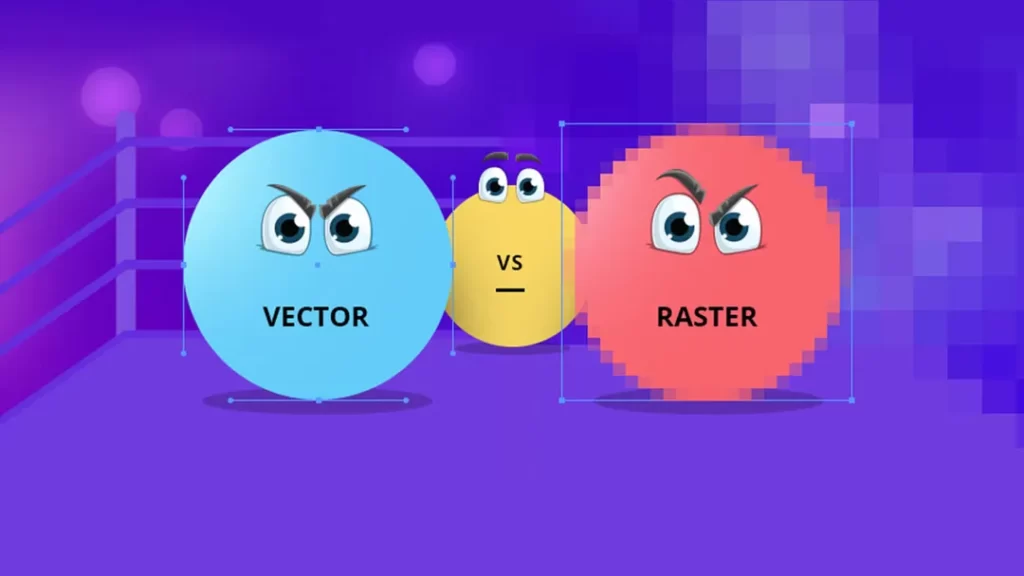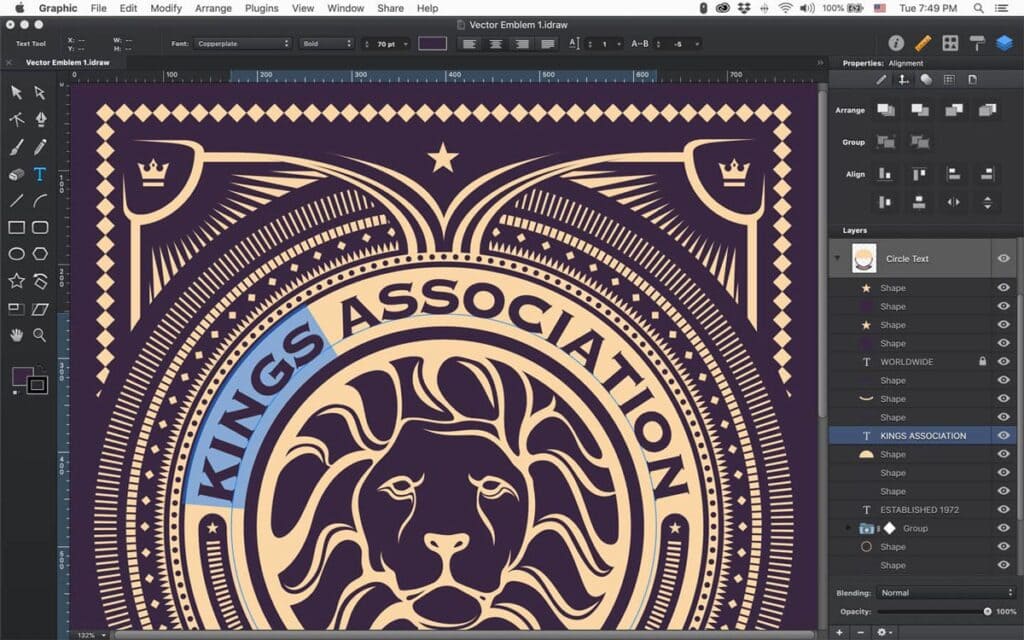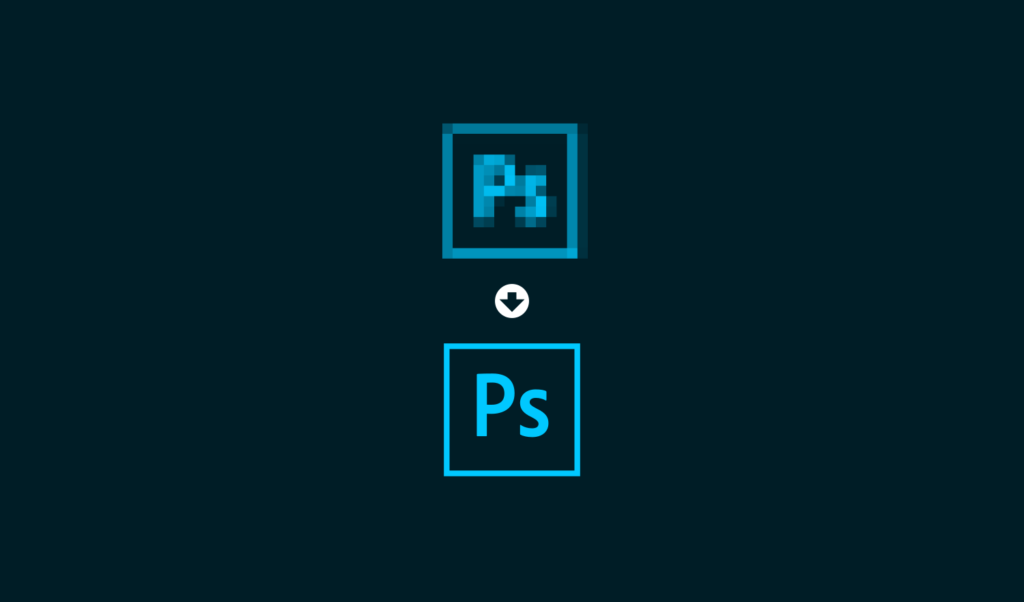Vector vs Raster Images: Choosing the Right Format
Whether you're a seasoned designer or dipping your toes into the vibrant visual art world, one age-old question always arises: “Vector vs raster?”
In this article, we'll take you through vector vs raster images to understand their fundamental differences and guide you in choosing your projects.
Picture this: you've been working hard on a project, whether designing a stunning logo, crafting an eye-catching poster, or creating jaw-dropping illustrations for your website. You want your work to look top-notch, but here's the thing—choosing the right image format can make or break your design!
On the one hand, we have vector images—the superheroes of scalability. These images are created using mathematical equations, meaning they're resolution-independent. No matter how much you enlarge them, they'll maintain crispness and clarity. That's right; you can stretch them to the size of a skyscraper or shrink them to the tiniest icon, and they'll still look picture-perfect.
On the other hand, we have raster images—those pixel-packed powerhouses. These graphics are composed of a grid of tiny coloured squares (pixels) and are perfect for capturing intricate details and breathtaking realism. They excel at representing photographs and complex artwork, making them a go-to choice for digital images everywhere.
But hold on; we're just getting started! In this article, we'll delve deeper into the strengths and weaknesses of both vector and raster images. We'll explore the best use cases for each format, so you'll never be scratching your head again, wondering which one to pick.
So, buckle up and get ready to empower your design skills! By the end of this read, you'll be armed with the knowledge to confidently choose between vector and raster images, ensuring your creations stand out like masterpieces in a world of visual wonders.
Table of Contents
Vector Graphics: Mastering the Art of Scalability

Understanding Vector Graphics
Vector graphics play a pivotal role in the ever-evolving digital design landscape. Unlike raster images composed of pixels, vector graphics are ingeniously crafted through mathematical equations, defining precise lines, smooth curves, and geometric shapes. At the heart of vector graphics lie points, which harmoniously interconnect to form elegant paths, providing designers with unmatched flexibility and creative potential.
The true magic of vector graphics lies in their remarkable scalability. This transformative characteristic allows them to be resized infinitely without losing quality. Whether you need to enlarge a vector logo for a billboard or shrink it for a tiny icon, the graphic maintains its sharpness and clarity, ensuring a consistent and captivating visual representation across various sizes and platforms. This scalability advantage sets vector graphics apart from their raster counterparts, which often suffer from pixelation and blurriness when enlarged beyond their original dimensions.
The elegance of vector graphics extends well beyond their scalability. Designers have precise control over every artwork aspect since they are fundamentally constructed using mathematical equations. This level of precision empowers creators to make fine adjustments effortlessly, ensuring that each element aligns perfectly with the overall design vision. From adjusting line thickness to modifying the curvature of a shape, vector graphics offer a playground of creative possibilities where imagination knows no bounds.
One of the most significant advantages of vector graphics is their suitability for various design applications. They extensively use logo creation, illustration, typography, iconography, and user interface design. In logo design, vector graphics guarantee a professional and polished look, which is critical for representing brands across multiple platforms and marketing materials. Additionally, illustrators find vectors indispensable in creating scalable and captivating artwork for books, magazines, and digital media.
The popularity of vector graphics in typography stems from their ability to retain crispness and legibility even at small sizes. This makes them ideal for crafting distinctive fonts and typographic elements for various design projects. Moreover, vector icons have become essential to modern user interfaces, elevating the user experience with visually appealing, easily recognisable, and adaptive symbols.
Collaboration and version control in vector-based projects are also facilitated. Designers can easily share vector files with team members or clients, allowing for smooth communication and feedback loops. Moreover, saving and managing different vector graphic versions enables seamless iteration and experimentation, making it a valuable asset for creative workflows.
Advantages of Vector Graphics
- Infinite Scalability: Since vector graphics are resolution-independent, they can be scaled up or down without losing quality. This feature makes them ideal for projects that require graphics to be displayed on various devices with different resolutions.
- Small File Sizes: Vector files are relatively smaller than raster images. They only store mathematical data for shapes and paths rather than recording every pixel, resulting in reduced file sizes.
- Easy Editing and Customisation: Modifying vector graphics is a breeze. Designers can easily edit, resize, recolour, or tweak elements without sacrificing quality, making it convenient for iterative design processes.
- Print Perfection: Vector graphics are the preferred choice for print media. Whether business cards or large-format banners, vector images ensure crisp, high-quality prints.
Popular Use Cases for Vector Graphics

- Logo Design: Creating logos in vector format ensures the design can be scaled without losing sharpness, making it versatile across various branding materials.
- Illustrations and Icons: Vector graphics excel in creating illustrations and icons, where precise details and adaptability are essential.
- Typography and Lettering: For stylised typography and custom lettering, vectors allow designers to retain crisp edges, even when the text is enlarged.
Limitations of Vector Graphics
- Complex Photo Realism: While vector graphics are excellent for simple shapes and illustrations, they struggle with intricate photo-realistic images due to the complexity of replicating fine details using mathematical equations.
- File Compatibility: Not all software supports vector formats, and converting vector graphics to raster formats can sometimes lead to poor quality.
Raster Graphics: Embracing the World of Pixel Perfection

Understanding Raster Graphics
Raster graphics, called bitmap images, are digital images constructed using a grid of individual pixels, with each pixel assigned a specific colour value. Unlike vector graphics, which utilise mathematical equations to represent shapes and curves, raster images comprise many coloured dots that form the overall image.
The fundamental building blocks of a raster image, the pixels, play a crucial role in determining the image's appearance. Each pixel contains information about its colour, typically represented in the form of Red, Green, and Blue (RGB) values, which combine to create various hues and shades. The arrangement and colour values of these pixels determine the final visual output of the image.
One of the primary characteristics of raster graphics is their reliance on resolution. Resolution refers to the number of pixels per unit area in the image and is commonly expressed as pixels per inch (PPI) or dots per inch (DPI). The higher the resolution, the more pixels there are to represent the image, resulting in greater detail and clarity. Conversely, lower resolutions may lead to pixelation, where individual pixels become visible, and the image appears jagged or blurry.
Because raster images are constructed on a fixed grid of pixels, they do not possess inherent scalability. When attempting to resize a raster image to a larger dimension, the software must interpolate the existing pixel information, which can lead to a loss of quality. Enlarging a raster image too much may cause it to appear pixelated or blocky.
Standard formats for raster images include JPEG, PNG, BMP, and GIF. These formats are widely used for photographs, digital artwork, and any image that contains intricate details. Raster images are particularly well-suited for capturing complex, realistic scenes, as they can represent subtle variations in colour and tone.
However, despite their advantages in capturing intricate details, raster graphics have limitations in specific applications. For instance, vector graphics are preferred when images must be scaled up significantly without losing quality. Vector graphics use mathematical equations to define shapes, allowing them to be resized without sacrificing clarity.
Raster graphics use extensively in digital photography, web graphics, and digital art, showcasing their ability to create lifelike visuals. On the other hand, vector graphics excel in fields such as logo design, typography, and illustrations, where scalability and precise shapes are paramount.
Advantages of Raster Graphics
- Photorealism and Detail: Raster images render complex photo-realistic scenes and intricate details, making them the go-to choice for digital photography and digital art.
- Natural Color Gradients: Raster images can effectively capture smooth colour gradients, making them suitable for capturing natural landscapes and digital paintings.
- Wide Software Support: Raster formats like JPEG, PNG, and GIF are widely supported by various software and web browsers, ensuring easy sharing and viewing across platforms.
- Photo Editing Flexibility: Raster graphics offer more flexibility in post-processing and editing with software like Adobe Photoshop, enabling designers to apply various filters and effects.
Popular Use Cases for Raster Graphics

- Digital Photography: Raster images are the standard format for capturing photographs with digital cameras and smartphones.
- Web Graphics: Raster graphics are commonly used for web graphics like banners, sliders, and social media posts.
- Digital Art and Illustrations: Artists often prefer raster-based tools for creating detailed digital artwork and illustrations.
Limitations of Raster Graphics
- Resolution Dependence: Raster images are bound by their resolution, and enlarging them often results in pixelation and loss of quality.
- File Sizes: High-resolution Raster images can lead to large file sizes, affecting website loading times and storage requirements.
- Editing Constraints: While raster graphics can be edited, resizing or significant modifications may compromise image quality.
Making a choice: When to Use Vector or Raster Graphics?

The decision to use vector or raster graphics largely depends on the specific project requirements and the intended output. Let's explore some common scenarios to help you make an informed choice:
When to Choose Vector Graphics
- Logo and Branding: For creating logos and brand assets, vector graphics are the preferred choice due to their scalability and flexibility in adapting to different sizes and mediums.
- Print Design: When designing materials for print media, such as brochures, business cards, and posters, vector graphics ensure sharp and high-quality output.
- Iconography and Illustrations: Vector graphics shine in producing icons, infographics, and simple illustrations, especially when they need to be resized or repurposed frequently.
When to Choose Raster Graphics
- Digital Photography: Raster images are the natural choice for capturing photographs, preserving every detail.
- Digital Art and Photo Manipulation: Artists and photographers often prefer raster graphics for their creative freedom and the ability to apply various effects and filters.
- Web and Screen Graphics: Raster graphics are widely used for web graphics, as they offer better colour fidelity and a wide range of format options suitable for different web platforms.
Vector vs Raster in Modern Design Workflow
In contemporary design workflows, designers often use vector and raster graphics, leveraging the strengths of each to achieve their creative vision. Here's how these two formats complement each other:
- Combining Vector and Raster Elements: Designers often combine vector and raster elements in their projects. For instance, they might create the main layout and typography using vector graphics while integrating raster images for background visuals or detailed illustrations.
- Exporting for Different Platforms: Designers frequently need to export their work in various formats. They might design a logo in vector format, then export it to raster formats like JPEG or PNG for web use.
Conclusion
There is no one-size-fits-all answer in the eternal debate of vector vs raster. Both formats have their unique strengths and serve different purposes in graphic design. Vector graphics excel in scalability, small file sizes, and ease of editing, making them ideal for logos, icons, and print design. On the other hand, raster graphics shine in photorealism, capturing intricate details and providing flexibility for photo editing and digital art.
As a graphic designer, understanding when and how to use vector or raster graphics will empower you to create visually stunning and practical designs that meet your project's requirements and resonate with your audience. So, embrace both formats in your design journey and let your creativity flow, using the best of both worlds to bring your artistic vision to life.
